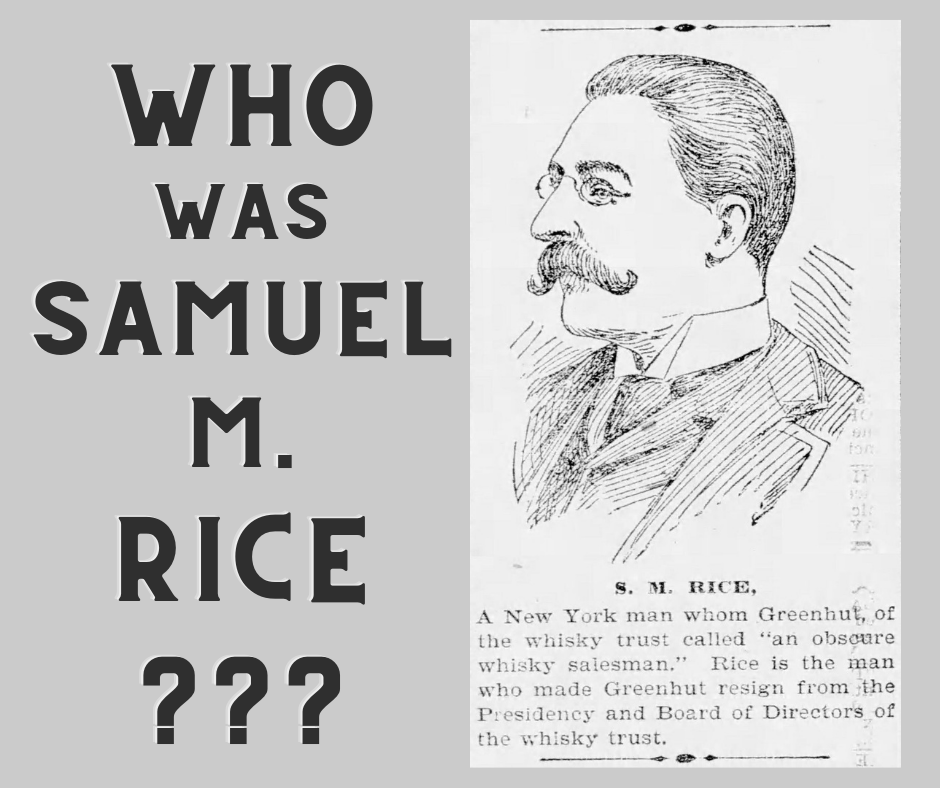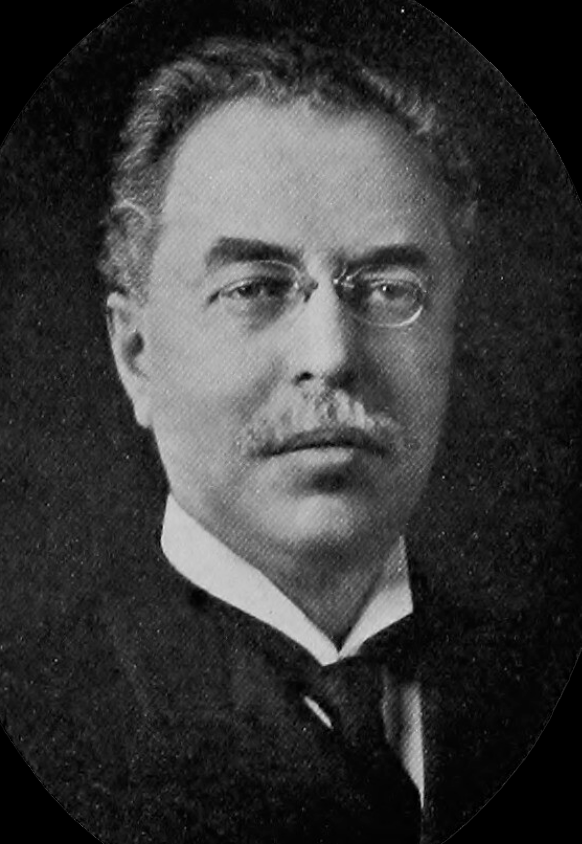The following are two separate posts that I wrote for my Facebook page- @AmericanWhiskeyHistory. I have been putting historic posts on my page every day for almost a year and a half as of February 2024, so there is a great deal of content that I have not published on this blog site. Please feel free to visit my page and see what I’ve been writing about! Here are two consecutive posts that I wrote on Colonel Samuel M. Rice. He is one of those big, pivotal players in American whiskey history that no one seems to know anything about. I hope this helps to shed some light on this very influential man of mystery.

(Part 1)
While looking at my files on “whiskey salesmen,” I spotted what seemed like an out-of-place image of Samuel M. Rice. I’d never describe S.M. Rice as a “salesman”, so I wondered what he was doing there. I organize these files, after all! Rice was the president of the American Spirits Manufacturing Company, which was the largest whiskey corporation in the US before Prohibition! He was the man who overthrew and succeeded Joseph H. Greenhut, the OG behind Peoria’s Whiskey Trust! But, there he was in my “salesmen” file. As it turned out, the reason he was in there was because Joseph Greenhut had publicly dismissed any accusations that Rice could pose a threat to him in the newspapers. Greenhut attempted to belittle Samuel Rice by telling reporters he was nothing but “an obscure whiskey salesman!” The insult was printed in many different newspapers across the country, often as the opening line.
What I find so interesting is the use of “whiskey salesman” as an insult! Whiskey salesmen, after all, had the ear of the consumer before Prohibition. (They still do!) They often knew what the fat-cats in their big, fancy offices did not – what consumers wanted and how to get it to them. As the Whiskey Trust was failing in its efforts keep the industry under its boot with its rebate system and by squeezing the public with its added costs, Samuel Rice and other very influential liquor men were quite successfully creating direct competition for the Whiskey Trust. S.M. Rice had risen in the industry as a representative of the Hanover Distilling Company- this was what Greenhut was hinting at with his insult. The insult did not phase Samuel Rice in the least, because he was financially supported by independent eastern liquor interests. These eastern interests had spent the years 1892 and ’93 building the largest distilleries that the US had ever seen! One of these mega-distilleries, the Atlas Distilling Company in Peoria, Illinois, was founded by the Woolner Brothers and S.M.Rice. Other efforts to build mega-distilleries to compete with the Trust were led in Philadelphia by Angelo Myers (the Philadelphia Pure Rye Whiskey Distilling Company in Eddington, Pa) and by William Lee in St. Louis with the Central Distilling Company. They were not alone in these construction efforts, but all the whiskey production in the world wouldn’t mean anything without a means to distribute it. So…Samuel Rice helped to fund a new distribution company that would ONLY cater to independent firms and allow all these recently built whiskey mega-distilleries to compete against Greenhut’s Whiskey Trust. S.M. Rice, with all his industry experience and all his work as a “whiskey salesman,” was able to understand that the TRUE key to America’s whiskey industry didn’t lie in production. The key to industry dominance lay in DISTRIBUTION. And perhaps it took the wisdom of a whiskey salesman to take down the beast that was the Whiskey Trust.
But don’t go thinking that Samuel Rice was a noble knight in shining armor. The moment he was able to prove to the board of the Whiskey Trust that Joseph Greenhut, that blustery bully from Peoria, was no longer an asset to them, S.M. Rice was voted in to replace him. The man that was so anti-Whiskey Trust that he labored to bring down the beast, simply became its new face. He didn’t just take over, his ambitions were WAY bigger. More on that tomorrow…
(Part 2)
S.M.Rice doesn’t even come up when you google him! How can I sit here and tell you what a big name he was in American whiskey history if he doesn’t show up on Google? Well, what can I say? There are always going to be huge influencers on history that don’t get the attention they deserve. If you’ve read my recent post on Seton Porter, you might already know what I’m getting at…Don’t just take my word for it- Read the articles I’ve attached (below) from the 1890s
If you follow American whiskey history at all, perhaps you’re used to hearing about the Whiskey Trust and the man behind it- Joseph Greenhut. Greenhut founded the Distillers and Cattle Feeders Trust (aka the Whiskey Trust) in 1887. After the the Sherman Anti-Trust Act in 1890, he managed to reorganize the trust into the Distillers and Cattle Feeders COMPANY. During those early years as a legal company, Greenhut steamrolled through the industry, but by 1893, his company was suddenly facing dissolution. Overspeculation and price manipulations in the liquor market had inadvertently created a new and profitable opposition to the Trust. The market, during the early 1890s, was highly competitive as new, very large distilleries were coming online- all built specifically to compete with the trust. Greenhut was losing his grip on the market, and the board began to see him as a liability.
The most direct competition for Greenhut came from the independent eastern distillers and liquor men that either refused to sell to the trust or had withdrawn their businesses entirely. One particular group of anti-trust advocates, the Woolner Brothers of Peoria, withdrew their Grove and Union Distilleries in 1893, bringing several other large concerns with them. They had not received the rent they were owed by the trust and abruptly abandoned their leases, effectively collapsing the trust by removing one of its largest assets. Meanwhile, these large, anti-trust distillers were already working in concert with other well-funded companies to undermine the success of the trust. They accomplished this by establishing their own, independent distribution network. While the trust flailed, the new combination of independents surged ahead. And the man at the center of all these strategic moves? None other than Samuel M. Rice.
S.M. Rice, and a growing number of whiskey men looking to rid themselves of the old guard, moved to restructure the whiskey industry. As Joseph Greenhut stomped his feet and cried foul at these efforts, Samuel Rice was quietly positioning himself as a competent leader within the whiskey industry. The board of the trust already wanted to oust the powerful Greenhut, so they brought Samuel Rice on as a paid advisor. By 1895, he was voted in by the board as the new president of the Whiskey Trust.
Samuel Rice and the trust restructured the assets of the old Distillers and Cattle Feeders Company and formed the American Spirits Manufacturing Company (ASMC). The ASMC was incorporated on August 23, 1895 with a total capital of $35 million. Its main office was removed from Peoria and placed in New York City, which was where power was recentering itself within the trade. The newspapers continued to describe the companies that had abandoned the trust in 1893 as remaining “hostile to the trust,” though is it difficult to believe that was the case with one of its most hostile opponents now at its helm.
Samuel Rice was from a family of reformers, and his reputation for fighting the trust made him a refreshing option to lead the “new trust” into the future. His ideas were modern and had more far-reaching implications. Rice would lead the incorporation of the Distilling Company of America (1899), a company comprised of not only the American Spirits Manufacturing Company (the new face of the trust), but all its new assets- including the vast distribution networks and accumulated distillery properties it had acquired. Like Greenhut before him, he sought to control output and prices, but with more competence, careful legal oversight, more foreign investment, and influence over government insiders. By the late 1890s, the ASMC had acquired the majority of the distilleries in Kentucky and was keen to place those assets at the center of their new business plan. Samuel Rice saw the opportunities that awaited the American whiskey industry in foreign markets and began to push for more streamlined trade with Europe. Following the lead of the oil industry, Rice wanted to begin to scale up trade with Europe through the use of tankers instead of wooden barrels. The moves he was making inspired the eastern whiskey men to form new combinations to defend their own interests. By 1898, Joseph Greenhut was back forming combines to undermine the company that had ousted him, but his efforts quickly became new assets for the ASMC. The only whiskey interests to escape the machinations of Samuel Rice were the rye whiskey distillery owners. Rice was able, however, to gain a strong influence over the Philadelphia market through his connection to Angelo Myers and the wholesale liquor dealers association. There seemed to be no stopping the new president of the Whiskey Trust.
Samuel Rice was an incredibly dynamic leader in the whiskey industry around the turn of the 20th century. With the support of many other powerful whiskey men, he transitioned from a powerful adversary of the trust to its central figure in only a few years. As the new era for dominance within the industry unfolded, S.M. Rice became a pivotal figure. Perhaps Rice’s chameleon-like personal transition from enemy to president helped him flip the trust’s image from “enemy of the taxpayer” to “steward of the American whiskey industry.” He opened the door for the trust to becoming a real, and somehow legally acceptable, monopoly of the whiskey industry. Even as he retired his presidency of the Distilling Company of America in 1901 (the company was unable to meet its ultimate goals without the acquisition of the Pennsylvania and Maryland rye whiskey distilleries), he would remain an important figure with the trust. He would continue to exert his influence on the industry for years to come and became president of the Kentucky Distillers and Warehouse Company in 1908.



